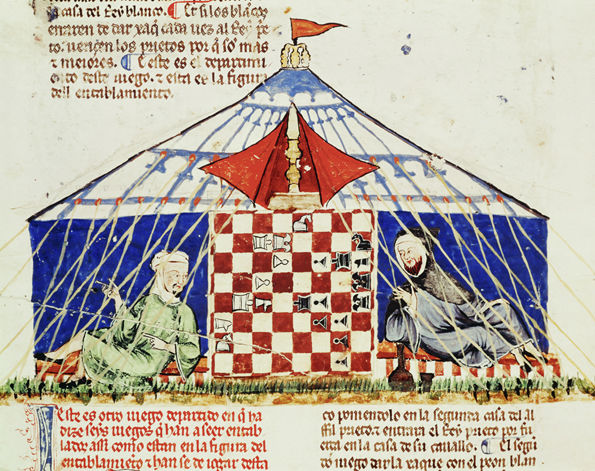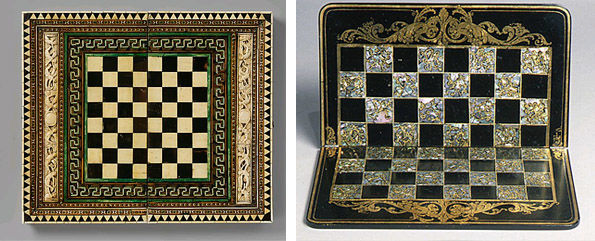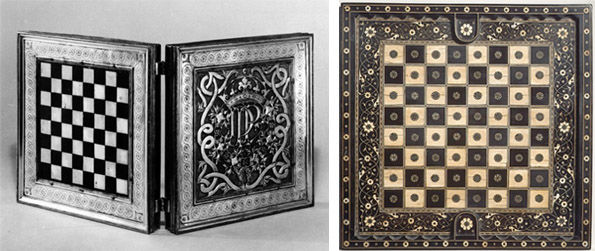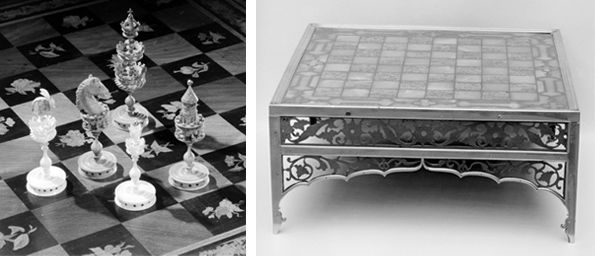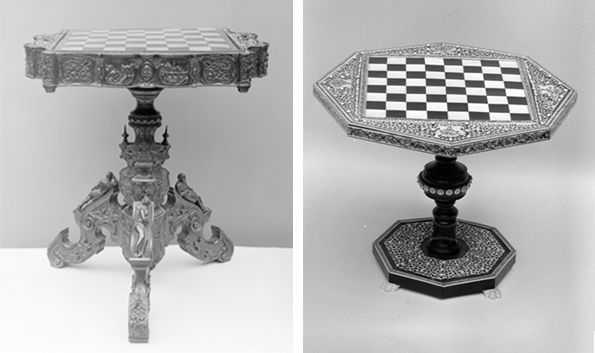The Metropolitan Museum owns more than forty chessboards dating from the Renaissance through the twentieth century; some private collectors have hundreds of boards. Medieval chessboards, on the other hand, rarely survive in any collection, and our knowledge of them depends largely on written sources. While some legends focus uniquely on the fact that they were big and heavy enough to be wielded as lethal weapons (see "An Epic Battle"), more nuanced information can be also gleaned from literature, from chess treatises, and from princely inventories.
Checkered boards came into use gradually in medieval Europe. The author of the Einsiedeln Poem concerning chess, dating to about 1100, observes that it is easier to play on a board that has been "chequered," but it is clear that the usage was not yet standardized. Sometimes, as we have seen in the Book of Games of 1283, the squares were distinguished by the colors red and white:
"Arabs Playing Chess," from the Book of Games (fol. 62v), by Alfonso X the Wise (1221–1284). Spain, 1283. Real Biblioteca del Monasterio de San Lorenzo del Escorial. Photo: Erich Lessing / Art Resource, NY
The idea was to have contrasting colors, but black and white was not yet the rule. The modern practice of placing a white square at the right-hand corner of each player was also not yet the expectation. Some sources indicate that the queen be placed on her own color, but others do not.
We learn from an unlikely religious source—the Book of Miracles of Saint Foy, written around the year 1010—that chessboards were sometimes hung on a castle wall. The accounts of Saint Foy's miracles include the dramatic prison break she arranged for a wrongly incarcerated knight, Raymond of Montpezat. As he fled the castle where he had been held, Raymond saw a chessboard hanging in the great hall. To pay tribute to the saint, he stole the board as he fled, and then offered it in thanks to Saint Foy's shrine at Conques.
Turning to courtly legend, one of the tales of King Arthur describes the great hall of a castle that was itself transformed into a giant chessboard, with lifesize pieces that moved when touched by a magic ring, an idea that has echoed down the centuries and found a modern equivalent in Alexander McQueen's spring/summer 2005 collection, "It's only a game."
In a different Arthurian legend, a magician called Gwenddolen creates a chessboard of silver and ivory that flies through the air to the court of King Arthur. We know that silver and ivory were used to make chessboards—even if they didn't fly—along with other precious materials. In an earlier post ("All Set"), I mentioned that chess pieces and boards of crystal and jasper were particularly favored among French and English princely players of the fourteenth century. Jean de Berry owned a chessboard of jasper and crystal that had previously been the property of the Avignon Pope Gregory XI (r. 1370–78), whose coat of arms it bore. In some cases the materials of the board corresponded to the chess pieces, as was true of a jasper and crystal ensemble that Jeanne d'Evreux bequeathed to Margaret of Flanders, wife of Philip the Bold, in 1371. A beautiful and rare folding jasper and crystal chessboard from around 1300, with a backgammon board on the reverse, is preserved in the Stiftsmuseum, Aschaffenburg. A gift of Cardinal Albrecht of Brandenburg (1490–1545) to the Church of Saints Peter and Alexander, it owes its survival to having been incorporated into a medieval reliquary.
The materials used for the board could also be distinct from the chessmen. In the study of his castle at Saint-Germain-en-Laye, King Charles V of France kept a round ivory box painted on the top and bottom for games of chess and "tables" (backgammon). The only chess pieces he owned did not match it, but were of amber and jet.
Amber chess pieces appear infrequently in medieval inventories, and surviving examples of amber chess pieces and boards date well after the Middle Ages.
Left: Chessmen (32) and Box-Board, 19th century. German. Amber, leather, brass. The Metropolitan Museum of Art, New York, Gift of Gustavus A. Pfeiffer, 1948 (48.174.72a–p, aa–pp, q); Right: Chess and Backgammon Board, 17th–18th century, Königsberg (?). Amber, ivory, brass, ebony. The Metropolitan Museum of Art, New York, Gift of Gustavus A. Pfeiffer, 1948 (48.174.41)
Later chessboards of fine materials in the Metropolitan's collection range from alabaster and lapis to Meissen porcelain.
Left: Chessboard, late 19th century. Indian. Alabaster, lapis. The Metropolitan Museum of Art, New York, Gift of Gustavus A. Pfeiffer, 1948 (48.174.48); Right: Designer: Max Esser. Manufactured by Meissen State Porcelain Factory. Chess set, 1931, German (Meissen). Porcelain. The Metropolitan Museum of Art, New York, Gift of Gustavus A. Pfeiffer, 1948 (48.174.93a–p, aa–pp, q, s)
Already in the Middle Ages, chessboards were often made to fold in half and to serve a dual purpose—for playing chess and another game.
Left: Folding Game Board, 15th century. Italian, made in Venice. Bone, wood, horn, stain and gilding over wood core with metal mounts. The Metropolitan Museum of Art, New York, Gift of The Salgo Trust for Education, New York, in memory of Nicolas M. Salgo, 2010 (2010.109.4); Right: Chessboard, 19th century. English. Lacquered wood. The Metropolitan Museum of Art, New York, Gift of Gustavus A. Pfeiffer, 1953 (53.71.44)
The Metropolitan's collection includes a rectangular inlaid box of bone and wood for chess and tables of the fourteenth–fifteenth century, too humble for the likes of King Charles V, but which could accommodate game pieces on the interior.
Game Box, 14th century. Italian. Bone, wood, stain over wood core with paper and textile lining, metal mounts. The Metropolitan Museum of Art, New York, Gift of The Salgo Trust for Education, New York, in memory of Nicolas M. Salgo, 2010 (2010.109.5)
The pairing of chess and tables is also found on a Spanish example of the sixteenth century (ca. 1518–56) bearing a monogram identified as that of Don Diego Lopez Pacheco, 3rd Duke of Escalona, whereas an ornate Italian chessboard of the seventeenth century flips over in its frame to allow its owner to play the game called "Goose"!
Left: Chess and Tric-Trac Board, ca. 1518–56. Spanish (Castilian). Copper-gilt, walnut, ivory, mother-of-pearl, serpentine, rosso antico marble. The Metropolitan Museum of Art, New York, Pfeiffer Fund, 1963 (63.38); Right: Chess and Goose Game Board, second half 17th century. North Italian. Ebony, ebonized wood, ivory, green-dyed ivory, horn, gold wire. The Metropolitan Museum of Art, New York, Pfeiffer Fund, 1962 (62.14)
The inventory of Jean, duc de Berry (brother of Charles V and an insatiable collector) lists five chessboards. Most remarkable was a chess table described in the prince's inventory in 1416. Made of expensive Roman porphyry, it folded in three, to accommodate chess games, tables (backgammon), and merels (a board game also known as "Nine Man Morris").
Chessboards were also incorporated into freestanding tables. A table found in the kitchen of the Crusader Castle at Belvoir in the Holy Land was carved on the underside of a stone mortar. At another castle, a game board was ruled into a table of the refectory. While these examples are rather rudimentary, some chess tables were actually quite elaborate. The Metropolitan owns two highly decorative Italian chess tables of the nineteenth century, others of ivory and one board of jade raised on delicate, openwork metal legs from India.
Left: Workshop of Michel Grandville (active 1870–80). Chess Table, ca. 1870–80. Italian (Sorrento). Wood. The Metropolitan Museum of Art, New York, Gift of Gustavus A. Pfeiffer, 1948 (48.174.177); Right: Chess Table, 19th century, Indian. Jade, jasperite, brass, steel. The Metropolitan Museum of Art, New York, Gift of Gustavus A. Pfeiffer, 1948 (48.174.70)
Left: Fabbrica C.V. Chess Table, 1856. Italian (Parma). Wood. The Metropolitan Museum of Art, New York, Gift of Gustavus A. Pfeiffer, 1953 (53.71.126); Right: Chessboard, 19th century, Indian. Ivory, horn, wood. The Metropolitan Museum of Art, New York, Gift of Gustavus A. Pfeiffer, 1948 (48.174.67)
The design of chessboards is an abiding fascination; the Metropolitan's collection includes one created by Man Ray in 1962.
Information about chessboards in the Holy Land is taken from Adrian J. Boas, Archaeology of the military orders: a survey of the urban centers, rural settlements and castles of the military orders in the Latin East (ca. 1120–1291), Abingdon, England and New York, 2006, p. 203. Other references can be found in Murray, History of Chess, Oxford, 1913 and published inventories of medieval French royalty.
